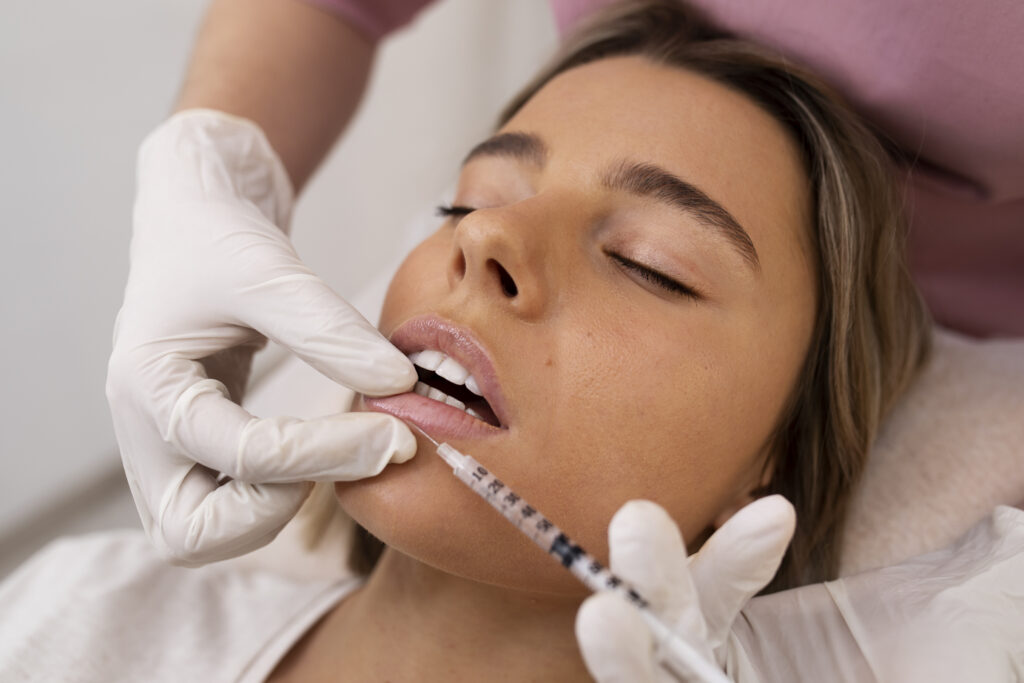Table of Contents

Introduction
Lip fillers have surged in popularity as a cosmetic enhancement, enabling individuals to achieve fuller, more defined lips. However, complications like lip filler migration can occasionally occur. Although rare, this issue can lead to significant distress and aesthetic concerns. For anyone considering or who has undergone lip augmentation, understanding lip filler migration is crucial.
Defining Lip Fillers
Lip fillers are injectable treatments crafted to boost the volume, contour, and definition of the lips. A variety of lip fillers are available, including:
Types of Lip Fillers
- Hyaluronic Acid (HA) Fillers: The most common type, offering a natural look and feel.
- Collagen Fillers: Less common today, replaced largely by HA fillers.
- Fat Transfer: Using the patient’s own fat, a more invasive but longer-lasting option.
How Lip Fillers Work
Lip fillers are injected into specific areas of the lips to enhance volume and shape. The substance then integrates into the tissue, providing a plumper appearance.
Causes of Lip Filler Migration
Lip filler migration occurs when the filler moves from the intended site to another area, causing asymmetry or lumps. Several factors can contribute to this:
Injection Technique
Improper injection technique, such as injecting too superficially or too deeply, can cause the filler to move.
Type of Filler Used
Certain fillers are more prone to migration. For instance, softer fillers might move more easily than denser ones.
Physical Activity Post-Procedure
Excessive movement or pressure on the lips shortly after the procedure can push the filler out of place.
Individual Anatomy
Everyone’s facial anatomy is different, and certain anatomical features may predispose someone to filler migration.
How Long Does Lip Filler Last
Symptoms of Lip Filler Migration
Recognizing the signs of filler migration early can help in managing the issue effectively.
Visual Changes
Visible lumps or unevenness in the lips can indicate migration.
Sensory Changes
Changes in sensation, such as numbness or a feeling of tightness, can be symptoms.
Time Frame for Symptoms to Appear
Symptoms may appear immediately or develop over several weeks.
Risks and Complications
Understanding the potential risks can help in making an informed decision about lip fillers.
Aesthetic Concerns
Uneven lips or lumps can affect the overall look, leading to dissatisfaction.
Health Risks
In rare cases, migration can lead to infections or tissue damage.
Long-Term Effects
Repeated migration issues can cause scarring or permanent asymmetry.
Preventing Lip Filler Migration
While completely preventing lip filler migration may not be possible, several steps can significantly minimize the risk.
Choosing a Qualified Practitioner
Selecting a skilled and experienced practitioner is essential for a successful outcome.
Proper Aftercare
Diligently following aftercare instructions can help maintain the filler in place.
Understanding Your Anatomy
Being aware of how your unique anatomy might affect the filler can aid in planning the procedure.
Avoiding Certain Activities
Avoid strenuous physical activities and applying pressure to the lips immediately after the procedure.
Diagnosing Lip Filler Migration
If you suspect migration, it’s important to seek professional advice.
Consulting a Professional
A practitioner can assess the situation and recommend appropriate action.
Imaging Techniques
In some cases, imaging tests might be needed to locate the filler.
Self-Assessment Tips
Being aware of normal post-procedure changes versus signs of migration can help in early detection.
Treatment Options
Several treatment options are available if migration occurs.
Hyaluronidase Injections
An enzyme that can dissolve HA fillers, offering a non-invasive solution.
Surgical Options
In severe cases, surgery might be needed to remove the filler.
Natural Dissolution
In some instances, waiting for the filler to naturally break down over time is an option.
Role of Practitioners in Preventing Migration
Practitioners play a key role in minimizing the risk of filler migration.
Expertise and Training
Ensuring your practitioner is well-trained and experienced can make a significant difference.
Importance of Technique
Proper technique in injecting the filler is critical to avoid migration.
Follow-Up Care
Regular follow-up appointments can help in early detection and management of any issues.
Patient Responsibilities
Patients also have a role to play in preventing migration.
Following Aftercare Instructions
Adhering to aftercare guidelines is essential for the best results.
Recognizing Early Signs
Being aware of early symptoms can lead to prompt treatment.
Regular Check-Ups
Regular visits to the practitioner can ensure the filler remains in place and looks natural.
Future of Lip Filler Procedures
The field of cosmetic enhancements is constantly evolving.
Advances in Techniques
New techniques that reduce the risk of migration.
Improved Filler Materials
Development of safer and more stable filler materials.
Better Patient Education
Increasing patient awareness to prevent complications.
Conclusion
Lip filler migration, while concerning, can be managed and prevented with the right knowledge and practices. By choosing qualified practitioners, following aftercare instructions, and being aware of early signs, patients can enjoy the benefits of lip fillers without the worry of migration.
FAQs
Can lip filler migration be reversed?
Yes, hyaluronidase can dissolve migrated filler. Severe cases may need surgery. Consult a specialist for advice.
Are there safer alternatives to lip fillers?
Yes, lip implants or fat transfer are options. Implants are permanent but riskier, while fat transfer is more natural.
How often should I get lip fillers?
Lip fillers usually last 6 to 12 months. Regular check-ups with your practitioner help maintain the look.